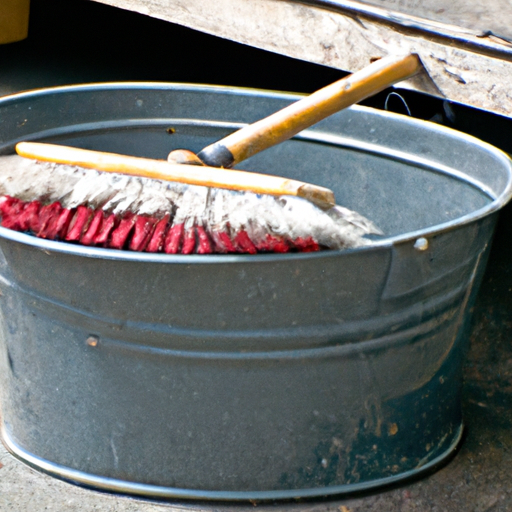If you’re a proud chicken owner, you know that providing a clean and comfortable environment for your feathered friends is crucial. However, those pesky mites and lice can quickly become an unwelcome guest in your chicken coop. But worry not, because in this article, we will share some effective tips and tricks to help you prevent these tiny troublemakers from infesting your coop. From regular cleaning to natural remedies, we’ve got you covered. So, let’s dive in and ensure that your chicken coop remains a cozy and mite-free haven for your clucky companions.
Understanding Mites and Lice Infestations
Common types of mites and lice
Mites and lice are common parasites that can infest chicken coops. Some common types of mites include red mites, northern fowl mites, and scaly leg mites, while chicken lice can be categorized as body lice, wing lice, or shaft lice. These pests can cause irritation, discomfort, and reduced egg production in chickens if left untreated.
Signs of mites and lice infestations
It is essential to regularly inspect your chickens and coop for signs of mites and lice infestations. Some common signs include red mite droppings on perches and surfaces, irritated and pecked skin, feather loss, pale combs, and anemia in severe cases. If you notice any of these signs, it is crucial to take immediate action to prevent the infestation from spreading.
Importance of preventing infestations
Preventing mites and lice infestations is crucial for the overall health and well-being of your chickens. These parasites not only cause discomfort and stress to your poultry but can also lead to decreased egg production and overall poor performance. By implementing preventive measures, you can maintain a clean and safe environment for your chickens, ensuring their optimal health and productivity.
Maintaining Cleanliness in the Chicken Coop
Regularly clean and disinfect the coop
One of the most effective ways to prevent mites and lice infestations is by regularly cleaning and disinfecting the chicken coop. Remove any droppings, old bedding, and debris from the coop, as these provide a perfect breeding ground for pests. Use a poultry-friendly disinfectant to clean all surfaces thoroughly, paying particular attention to roosting bars, nest boxes, and cracks where mites and lice may hide.
Remove and replace bedding regularly
Dirty bedding can harbor mites, lice, and other pests, so it is crucial to remove and replace it regularly. Use clean, dry bedding materials such as straw, wood shavings, or shredded paper and ensure it is changed at least once a week. By maintaining clean bedding, you create an inhospitable environment for pests, reducing the risk of infestations.
Keep the coop dry and well-ventilated
Mites and lice thrive in damp and poorly ventilated environments. To prevent infestations, it is essential to keep the coop dry and well-ventilated. Ensure proper drainage around the coop to prevent water accumulation and consider installing windows or vents to improve airflow. Good ventilation helps to reduce humidity levels and discourage the growth of mites and lice.
Creating a Safe Environment for Chickens
Provide dust baths for chickens
Dust baths are natural behaviors for chickens that help them keep pests at bay. Create a designated area in the coop or run where chickens can take dust baths. Fill it with fine, dry soil or sand, and optionally add diatomaceous earth (DE) to enhance its pest-killing properties. As chickens roll and fluff themselves in the dust bath, any mites or lice present on their bodies are suffocated and expelled.
Use diatomaceous earth as a natural remedy
Diatomaceous earth (DE) is a fine powder made from the fossilized remains of diatoms. It is a natural, non-toxic treatment that can help eliminate mites and lice in the chicken coop. Sprinkle DE in areas where pests may hide, such as cracks, perches, and nesting boxes. DE works by dehydrating and damaging the exoskeleton of the insects, effectively eliminating them without harming the chickens.
Implement predator prevention strategies
Other animals, such as rodents or wild birds, can introduce mites and lice to your coop. Implementing predator prevention strategies, such as using predator-proof fencing, securing feed storage, and minimizing food spillage, can help reduce the likelihood of pests being brought into the coop. By keeping potential carriers away, you significantly decrease the risk of mites and lice infestations.
Implementing Preventive Measures for Chicken Coop Health
Quarantine new chickens before introducing them to the flock
If you are introducing new chickens to your existing flock, it is crucial to quarantine them first. Quarantining new birds allows you to observe and treat them for any potential infestations before they have the chance to spread to your existing flock. Keep the new chickens in a separate, well-maintained area for a minimum of two weeks and regularly inspect them for signs of mites or lice.
Trim excess vegetation around the coop
Overgrown vegetation around the chicken coop can create a favorable environment for mites and lice. Trim back any excess vegetation near the coop to limit hiding places for pests and improve overall airflow. Additionally, removing vegetation reduces the attractiveness of the area to rodents and other potential carriers of mites and lice.
Monitor and control rodent populations
Rodents can introduce mites and lice to your coop, so it is essential to monitor and control their populations. Inspect your coop for signs of rodents, such as droppings or gnaw marks, and take appropriate measures to eliminate them. Secure feed storage in rodent-proof containers and consider using traps or contacting pest control professionals to manage rodent populations effectively.
Using Natural and Chemical Treatments
Introduce beneficial insects like predator mites
Predator mites are natural enemies of chicken mites and can help control infestations when introduced into the coop. These tiny mites feed on and reproduce in the presence of chicken mites, reducing their numbers over time. Consult with a local agricultural extension office or poultry expert to determine the appropriate predator mites for your region.
Use insecticidal dust or sprays as directed
When natural remedies alone are not sufficient, the use of specific insecticidal dust or sprays may be necessary. Be sure to carefully read and follow the instructions on the product labels, as different products have different application methods and waiting periods before reintroducing chickens to treated areas. Chemical treatments should be used sparingly and only as a last resort.
Consider natural remedies such as garlic or essential oils
Certain natural remedies may help repel mites and lice when used properly. Garlic, for example, can be added to chickens’ feed or water in small amounts to deter pests. Essential oils, such as lavender or neem oil, can also be diluted and sprayed in the coop as a natural repellent. However, it is essential to research and consult with a poultry expert to ensure safe and effective use of these remedies.
Considering Integrated Pest Management Strategies
Identify potential hotspots for infestations
By identifying potential hotspots in your coop, you can implement targeted preventive measures and significantly reduce the risk of infestations. Hotspots can include areas of excessive moisture, accumulations of debris or droppings, or specific areas where chickens spend most of their time. Regularly inspect these areas and take proactive measures to mitigate any issues that may contribute to infestations.
Monitor and treat chickens individually if necessary
In some cases, individual chickens within a flock may require additional attention and treatment. By monitoring each chicken for signs of mites or lice, you can take prompt action to treat affected birds and prevent further infestations. Isolate and treat the affected chickens with appropriate remedies or seek professional advice if needed.
Seek professional advice for severe infestations
In severe infestation cases or if preventive measures do not seem to be effective, it is crucial to seek professional advice from a veterinarian or poultry expert. They can assess the situation, provide targeted treatment recommendations, and guide you in resolving the infestation. Professional advice and intervention may be necessary to ensure the health and well-being of your chickens.
Educating Yourself and Taking Proactive Measures
Learn about mite and lice life cycles
Educating yourself about the life cycles of mites and lice can help you better understand how to prevent and control infestations. By understanding their life cycles and behaviors, you can implement preventive measures at the appropriate stages to interrupt their reproductive cycles and limit their spread.
Regularly inspect chickens and coop for signs of infestations
Regular inspections of your chickens and coop are essential for early detection and prevention of mite and lice infestations. Check your birds for signs of irritation, feather loss, or abnormalities in their behavior. Inspect the coop for any signs of pests or potential problem areas. Early intervention is key to minimizing the impact of infestations on your flock.
Follow recommended vaccination and biosecurity practices
Apart from mites and lice, chickens are susceptible to various other diseases and infections. To maintain optimal health, it is crucial to follow recommended vaccination protocols and practice good biosecurity measures. Vaccinations can protect chickens from potentially devastating diseases, while biosecurity measures help prevent the introduction and spread of pathogens or parasites.
Maintaining a Healthy Diet and Nutritional Balance
Ensure chickens have a balanced diet
A healthy, balanced diet is essential for the overall health and resilience of your chickens. Provide a commercial feed specifically formulated for chickens, ensuring it contains the necessary nutrients, vitamins, and minerals. Consult with a poultry nutritionist if needed, to ensure that your chickens’ diet is appropriate for their age, breed, and production needs.
Supplement with vitamins and minerals if necessary
In some cases, supplementation with additional vitamins and minerals may be necessary to support your chickens’ immune system and overall health. Consult with a veterinarian or poultry nutritionist to determine if your chickens would benefit from specific supplements. Remember, a balanced diet is the foundation for good health, but certain circumstances may require targeted supplementation.
Avoid overfeeding or providing excessive treats
While treats can be a fun addition to your chickens’ diet, it is important to avoid overfeeding or providing excessive treats. Overfeeding can lead to obesity and other health issues, compromising their immune system and making them more susceptible to infestations. Moderation is key, and treats should be given sparingly, focusing primarily on providing a nutritionally complete feed.
Collaborating with a Veterinarian or Poultry Expert
Seek professional advice for preventative treatments
Collaborating with a veterinarian or poultry expert is invaluable when it comes to preventing mites and lice infestations in your chicken coop. They have the expertise and resources to recommend preventative treatments specific to your flock’s needs. Regular check-ups and discussions with these professionals can help ensure the long-term health and well-being of your chickens.
Discuss flock health and concerns regularly
Regular communication with a veterinarian or poultry expert allows you to discuss your flock’s health and any concerns you may have. They can provide guidance on best practices, answer questions, and address any specific issues you are facing. By maintaining open lines of communication, you can stay proactive and address potential problems before they become more significant.
Stay updated on the latest research and recommendations
The field of poultry health and management is continually evolving, with new research and recommendations emerging. Stay updated on the latest developments and industry standards by reading reputable publications, attending workshops or seminars, and engaging with online communities. By staying informed, you can adapt your practices and implement the most effective strategies to prevent mite and lice infestations.
Conclusion
Preventing mites and lice infestations in your chicken coop is vital for maintaining the health and productivity of your flock. By understanding the common types of mites and lice, recognizing the signs of infestations, and implementing preventive measures, you can create a safe environment for your chickens. Regular cleaning, proper ventilation, and targeted treatments, whether natural or chemical, can help control mites and lice populations. Additionally, collaborating with professionals, educating yourself, and maintaining a healthy diet further contribute to the overall well-being of your chickens. By being proactive and taking the necessary precautions, you can minimize the risk of infestations and enjoy a thriving flock.




